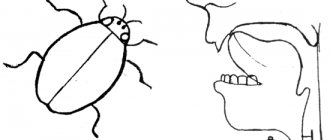3. Mechanism of development of stuttering
A complex and not fully established process. It is believed that under the influence of causes or provoking factors, Broca's center is overexcited, and its tone increases. Therefore, the speed of his work increases, and the speech circle opens. Next, overexcitation is transferred to areas of the cerebral cortex that are located nearby and are responsible for motor activity. This leads to muscle spasms occurring in the peripheral part of speech (tongue, lips, soft palate and others). Then Broca's center relaxes again, closing the speech circle. That is, a person begins to stutter due to a sudden disruption of the coordinated functioning of the speech organs when pronouncing sounds, which is caused by a spasm that occurs in one of the parts of the speech apparatus (tongue, palate, and others). It is noteworthy that both muscle spasms involved in the formation of sounds and breathing muscles can occur. As a result, not only stuttering develops, but also breathing is impaired (a feeling of lack of air appears). Stuttering mainly occurs on consonants, and less frequently on vowels. Moreover, hesitations most often occur at the beginning or middle of speech.
5.Stuttering in children
Most common. In general, the peak onset of the disease occurs in preschool age. The fact is that a child is born with underdeveloped cerebral hemispheres and cerebral cortex. Only by the age of five are they fully formed. Also, in young children, excitation processes predominate over inhibition processes. Therefore, excitation is easily transferred from sensory fibers to motor fibers. As a result, reactions in the form of a “short circuit” sometimes develop. In addition, the movements of the organs of articulation (tongue, lips and others) in babies are weak and insufficiently elastic, and their work is poorly coordinated. Hearing plays a leading role in the formation of speech, beginning to function from the first hours of a newborn’s life. However, children do not realize the difference between the sounds, syllables and words of those around them. Therefore, they understand speech poorly, mixing one sound with another. In addition, between the ages of 2 and 4 years, the child develops intensively and actively develops sound pronunciation and speech in general. However, at this age the speech function is not yet sufficiently formed. Therefore, the load on the nervous system increases, and its functioning may fail. It is these factors that explain the instability of the child’s speech and the high probability of developing speech disorders.
6. Risk factors for the development of stuttering in children
They only create the preconditions for the formation of stuttering. Emotionally labile nervous system
Babies are whiny, they have increased irritability, restless sleep and poor appetite, they are attached to their mother. A sharp change in environment can provoke the development of stuttering in children: starting to attend kindergarten, moving, a long absence from their mother, and so on. Early onset of speech At one year of age, children have a large vocabulary (normally, a baby correctly pronounces only 3-5 words). Subsequently, such children quickly increase their vocabulary: at 1.5-1.8 they already speak in expanded phrases or whole sentences. In this case, the baby loses his breath while pronouncing a long phrase. After all, he wants to tell everything at once. However, his tongue and lungs cannot yet cope with such a volume of speech. Late onset of speech The first correctly pronounced words in such children appear only at two years of age, and detailed phrases - no earlier than three years. Stuttering is caused by motor disinhibition of the nervous system. Therefore, babies often speak slurredly and pronounce sounds poorly. Stuttering in one of the family members. The child imitates his parents, brothers or sisters. Insufficient emotional contact between the child and others. Children do not receive enough affection and warmth. Adults do not listen to the baby, being busy with their own affairs. As a result, the baby feels unnecessary, so he may start to stutter so that his family will pay attention to him. Excessively strict attitude of adults towards children Dads are often the “sin” of this. Life is strictly on schedule: getting up, going to sleep, the barracks system of punishment, and so on. As a result, the baby grows up fearful and repressed, and is also afraid to make an independent decision so as not to anger the parent. Peculiarities of speech development At the age of 2 to 6 years, children often repeat or stretch out words and syllables, and sometimes insert extra sounds that carry neither semantic nor emotional meaning (“well,” “a,” “here,” and so on) B As a result, this habit is reinforced, creating the preconditions for the development of stuttering. Physical condition of the child Frequent colds, the development of allergic reactions, and the presence of congenital pathology push the baby to the realization that he is “not like everyone else.” Because there are often restrictions. After all, my mother constantly tells me: “Don’t eat orange/chocolate, because the rash will appear again,” “You can’t play in the yard, you’ll catch a cold,” and so on. As a result, the child withdraws into himself. In addition, frequent visits to medical institutions lead to the development of “fear of the white coat.” Mastering two or more languages at the same time Especially if parents speak different languages at home. In this case, the coordinated work of speech motor centers is disrupted. Because the baby is not yet fluent in his native language. Excessive demands on a child Sometimes parents want to demonstrate the extraordinary abilities of their child to all their acquaintances and friends. Therefore, they are forced to memorize complex poems and recite them at a birthday party or other family celebration. Whereas in the baby, the corresponding areas of the brain have not yet matured, and the muscles of the articulatory apparatus are not ready for such a load. Gender: Boys are more likely to develop stuttering than girls. Since girls develop motor functions in a shorter time: they begin to walk and talk earlier, and their motor skills (movement) of their fingers are better developed. Apparently, this is why girls’ nervous systems are more resistant to various factors that provoke the development of stuttering. Left-handedness
The harmonious interaction between the symmetrical structures of the brain of the right and left hemispheres is weakened. Therefore, the child’s nervous system becomes more vulnerable, which is reflected in the development of speech. Moreover, the risk of developing stuttering increases if they tried to retrain a left-handed child to use his right hand using crude methods. Hereditary predisposition Probably, the weakness of some brain structures that are involved in the formation of speech is inherited.
6.1 Reasons for the development of stuttering in children
There are several groups, but the reasons can often be combined. Condition of the central nervous system Children who have suffered diseases affecting the nervous system are prone to the development of stuttering: intrauterine hypoxia, trauma during childbirth, traumatic brain injury, infectious processes (caused by viruses, protozoa, bacteria, fungi) and other pathologies. After illnesses, there are residual effects that lead to structural changes in the brain (organic damage). As a result, insufficiency of the motor parts of the brain (for example, Broca's center) develops to varying degrees of severity. Therefore, the transmission of nerve impulses to the muscles from the central parts of speech is disrupted. While smooth speech requires coordinated work and maturity of the central nervous system. Such children are emotionally labile, impressionable, they have an increased level of anxiety, they do not adapt well to new conditions (for example, starting to attend kindergarten), they are timid, worried, and so on. Past mental trauma
Under the influence of stress, the coordinated redistribution of muscle tone involved in speech production is disrupted. That is, the muscles contract and relax inconsistently. Therefore, convulsive repetitions of sounds, syllables and words occur. Moreover, stress can be chronic or acute (fright, constant fear, death of a loved one, family troubles, etc.), and the strength of its impact does not matter.
7.Stuttering in adults
It occurs infrequently and, as a rule, begins in childhood. However, logoneurosis often appears in adults, causing the development of considerable problems: they withdraw into themselves, become timid and indecisive, avoid communicating with people, are afraid of public speaking, and so on. 8. Risk factors for developing stuttering in adults Male gender Men are more prone to developing stuttering than women. Professor I.P. Sikorsky explains this by the fact that in women the left hemisphere, in which Broca’s motor center is located, is much better developed than in men. Hereditary predisposition There is a congenital weakness of the central parts of speech, therefore, when exposed to unfavorable factors (for example, stress), their work is disrupted.
8.1 Causes of stuttering in adults
Stressful situations: the serious loss of a loved one, a road accident that happened before our eyes, military operations, an earthquake, disasters, and so on. Under the influence of stress, the coordination of the muscles responsible for producing sound is disrupted: they contract and relax inconsistently. As a result, muscle cramps develop. That is, there is a relationship with the emotional state of a person. Diseases of the central nervous system Traumatic brain injuries, previous neuroinfections (viral, bacterial, fungal, affecting the nervous system), encephalitis, meningitis and others. Because the transmission of nerve impulses from the brain along the nerve pathways to the muscles responsible for speech formation is disrupted. In adults, a major role in the occurrence of stuttering is played by previous strokes or the presence of brain tumors (benign, malignant), if the central parts of speech are affected. Because there is a mechanical obstacle to the transmission of nerve impulses. Moreover, in these cases there is no relationship between stuttering and emotional stress. That is, a person stutters at rest, alone with himself, when singing and talking in chorus.
How parents should behave if their child stutters
Only a doctor can determine the cause of a child’s stuttering and prescribe the correct treatment. However, the baby’s loved ones play an important role in eliminating the pathology. Parents should know how to handle their child so that the treatment process is faster and more effective.
- Make sure that the emotional stress on the child is moderate. Try to reduce the time you watch TV, protect your baby from aggressive games and loud music.
- Spend more time with your child, read fairy tales to him, try to ensure that spending time only evokes positive emotions in him.
- If a child likes to listen to music, then let it be calm.
- Establish a daily routine for your child, monitor his rest, regularly go out into nature, and take walks in the fresh air.
Under no circumstances should you scold your child if the defect cannot be treated for a long time. On the contrary, it is important to encourage the child, praise him for his efforts and patience, support the baby in every possible way and create a favorable, friendly environment in the family for the entire period of elimination of the defect.
After stuttering is overcome, parents should try to maintain a positive environment in the family. Only in this case will the risk of recurrence of stuttering in the child be minimized.
9.Types of stuttering
They are divided according to the form of seizures, clinical manifestations and course of the disease.
Types of stuttering according to the form of seizures
- Clonic stuttering is when several short-term spasms following each other lead to the involuntary repetition of individual syllables and sounds.
- Tonic stuttering - if the muscles contract for a long time and strongly. As a result, speech delay occurs.
- The mixed form develops when both types of speech impairment are combined.
In addition, sometimes violent and involuntary movements (convulsions) of the muscles of the face and/or limbs join the spasms of the muscles of the tongue, lips and soft palate. Types of stuttering along the way
- Constant - stuttering, having arisen, is constantly present in all situations and forms of speech.
- Wavy - stuttering does not disappear completely: it appears and then disappears.
- Recurrent (recurrent) - a speech defect, having disappeared, appears again. Sometimes after quite long periods of speech without hesitation.
Types of stuttering according to clinical forms
There are two forms of logoneurosis: neurotic and neurosis-like. The separation is based on different causes and development mechanisms. Neurotic form Patients have no data on the presence of intrauterine hypoxia or birth injuries in the past. The impetus for the development of stuttering is mental trauma (acute or chronic stress) or the early active introduction of a second language of communication (at 1.5-2.5 years). That is, the disease is functional in nature, and the brain structures are not affected. Therefore, this form of stuttering is more treatable. Characteristics of children prone to developing a neurotic form of stuttering Initially, such children are timid, impressionable, anxious, touchy, irritable, whiny, afraid of the dark, do not stay in a room without adults, have difficulty getting used to a new environment, and sleep poorly. Their mood also changes quickly, and more often downward. Mental, physical and motor development in children corresponds to their age. However, their speech development occurs somewhat earlier: the first words appear by 10 months of life, phrasal speech by 16-18 months. 2-3 months after the start of phrasal speech, children are already constructing complex sentences and speech structures. The pace of speech is accelerated: children “choke”, do not finish words, miss prepositions and words. In addition, speech is sometimes slurred.
10.Symptoms
In children, the disease occurs suddenly, usually between the ages of 2 and 6 years. Immediately after mental trauma, which becomes the “last straw,” the child stops speaking for some time (mutism). At the same time, an expression of fear is “written” on his face. Then, when the child begins to speak again, he already stutters. The baby becomes irritable and whiny, sleeps poorly, and is afraid to talk. When a second language is introduced, the child experiences mental stress as the load on the speech apparatus increases. While some children, due to age characteristics, have not sufficiently mastered their native language. Stuttering in a baby intensifies when exposed to any stress, emotional tension or anxiety. That is, the course of the disease is wave-like: periods of stuttering alternate with light intervals when the child speaks without hesitation. Whereas if the baby is sick (his body temperature rises, he coughs, and so on), then his stuttering does not get worse. The neurotic form of the disease occurs both favorably and unfavorably. In the first case, a cure occurs, and in the second, the disease becomes chronic. In the chronic course of the disease, stuttering becomes more and more severe over time. By the age of 6-7 years, children are reluctant to talk to new people. And at the age of 11-12, children’s behavior changes dramatically: they withdraw into themselves. Because they are well aware of their defect and are afraid of making an unfavorable impression on their interlocutor. Children develop logophobia - a fear of conversation with an obsessive expectation of speech failures. That is, a vicious circle is formed: convulsive stuttering in speech leads to the emergence of negative emotions, and they, in turn, lead to increased stuttering. Neurosis-like form In patients from the anamnesis (data from the past), it turns out that the mother suffered severe toxicosis during pregnancy, there was a threat of miscarriage, asphyxia (suffocation) or trauma during childbirth, and so on. That is, there is organic damage to the brain (dystrophic changes in brain cells), so this form of stuttering is more difficult to treat. For the neurosis-like form of stuttering, the manifestations of the speech defect do not depend on external factors (for example, emotional stress). Characteristics of children prone to developing a neurosis-like form of stuttering In the first years of life, such children are noisy, sleep poorly, restless, and fussy. Their physical development is somewhat behind that of their peers. They have awkward movements and poor coordination, they are disinhibited and easily excited, irritable and hot-tempered. Children do not tolerate heat, travel and stuffiness well. They get tired quickly and are also exhausted during physical and/or intellectual stress. They have delayed speech development, the pronunciation of some sounds is impaired, their vocabulary accumulates slowly, and phrasal speech is formed late. Symptoms In children, stuttering begins at about the age of 3-4 years for no apparent reason, increasing gradually. The beginning, as a rule, coincides with the formation of phrasal speech. In the first half of the year of the disease, periods with stuttering gradually become longer and appear more often, and “light” intervals (when the child does not stutter) are not observed. That is, the disease proceeds on “one note.” Next, children begin to add extra phrases and words that do not carry a semantic load (embolophrasia): “a”, “e”, “well” and others. At the same time, the pace of speech itself is either accelerated or slowed down. As a rule, there is a sharp disturbance in breathing during speech: words are pronounced at the moment of inhalation or at the end of a full exhalation. In addition, there is insufficient mobility, as well as coordination of the organs of articulation (tongue, palate, etc.), arms and legs. Also, spasms can occur in the facial muscles of the face or hands. As a rule, such children develop a poor ear for music. Upon examination, it turns out that most children have organic brain damage of a residual nature. Therefore, children often have decreased memory and performance, they quickly get tired and suffer from headaches, they have attention deficit and hyperactivity. In adults with a chronic course of this form of the disease, there are often severe convulsions in all parts of the speech apparatus. As a rule, their speech is accompanied by nodding movements of the head, monotonous movements of the fingers, swaying of the body, and others. That is, there is a forced contraction of other muscle groups that have nothing to do with the formation of speech. In severe forms of the disease, adults become tired of communication, so soon after starting a conversation they complain of fatigue and begin to answer in monosyllables. In addition, adults find it difficult to adapt to new conditions, they have decreased memory and attention, increased fatigue and exhaustion. Classes with a speech therapist bring relief to most patients, but only if the work is carried out regularly and for a long time.
Signs of stuttering
The pathology is manifested by the main symptoms, in the presence of which a specialist can make a diagnosis of stuttering. So, with such a speech disorder, a person maintains pauses between sounds and repeatedly makes syllable-sound repetitions. During speech, a spasm of the speech apparatus occurs, as a result of which it is difficult for the patient to breathe.
Stuttering is a pathology that is accompanied by additional symptoms, such as tearfulness, aggression, and nervousness. Often, children who stutter become withdrawn because they are afraid of becoming the subject of ridicule from their peers. Toddlers may be reluctant to go to daycare or play with other children. Children who stutter may develop pathologies of the nervous system, such as nervous tics. In some children, stuttering is accompanied by sleep disturbances, lack of appetite, and problems in the gastrointestinal tract.
In the absence of timely treatment, pathology can cause developmental delays, lack of desire to communicate with peers, and the formation of isolation. In adulthood, people with stuttering experience difficulties when applying for a job.





